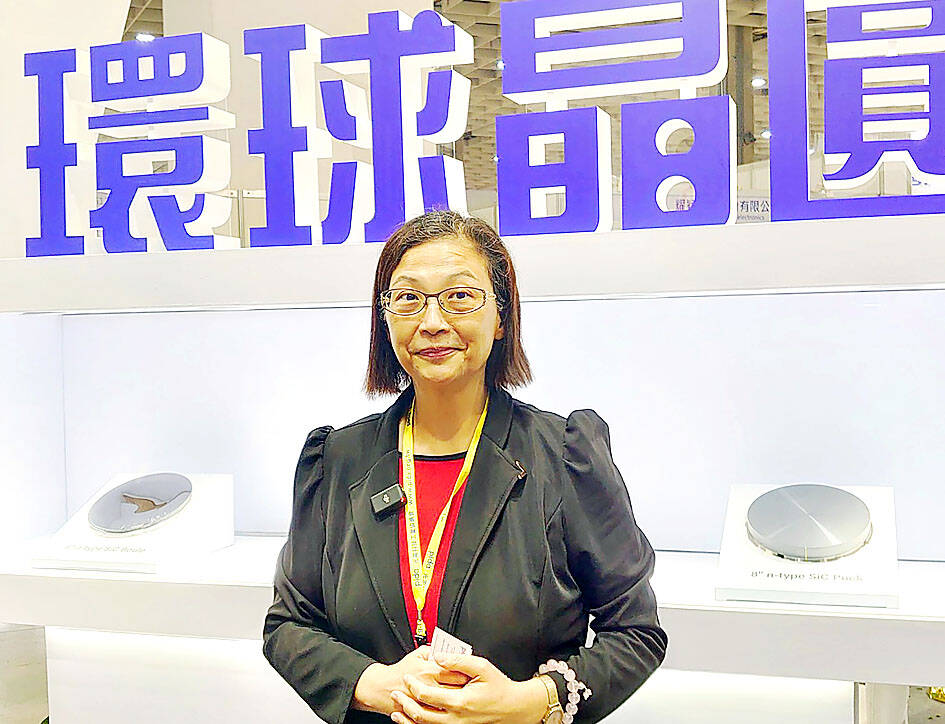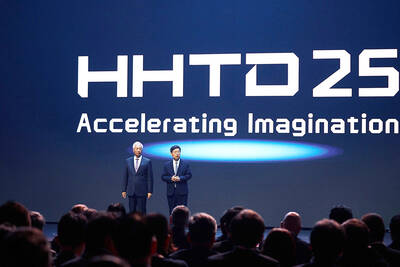Silicon wafer supplier GlobalWafers Co (環球晶圓) has independently developed the technology to produce high-quality 8-inch silicon carbide (SiC) wafers and expects to begin small-scale production by the fourth quarter next year, GlobalWafers chairwoman Doris Hsu (徐秀蘭) said yesterday.
Hsu made the comments at the company’s booth at the 31st International Optoelectronics Exposition (OPTO Taiwan), a three-day event that began on Wednesday at the Taipei Nangang Exhibition Center’s Hall 1.
SiC crystal growth to make the wafers presents challenges due to the need for growth in extremely high-temperature sealed environments, GlobalWafers said.

Photo: CNA
Faced with the difficulty, the company independently designed and developed a technology, called the 8-inch SiC-specific physical vapor transport (PVT) method, to reduce costs while achieving better quality control.
Although it has long been considered a potential semiconductor material, silicon carbide has only recently become viable with the development of new technologies to overcome production challenges.
SiC has several characteristics that make it a promising compound and alternative to silicon.
It is a “wide bandgap” semiconductor — meaning it has a greater energy range in which no charged states exist — and it is more tolerant of high temperatures, making it a better choice for high-power, high-temperature and high-frequency applications.
While 6-inch SiC wafers are mainstream technology, the development of 8-inch wafers has been “faster than she expected two years ago,” Hsu said.
Production is expected to ramp up in the fourth quarter of next year and accelerate in 2025, with the production of 8-inch substrates surpassing 6-inch substrates in 2026, she said.
Customers looking forward to the development are mainly in the automobile industry, and manufacturers of high-voltage and power devices, she added.
Asked whether production of SiC wafers would be mainly undertaken in Taiwan, Hsu said that the front-end production (crystal growth and processing) is done in Taiwan, while back-end production (epitaxy processing) in done in the US.
However, in the long run, production would be further segregated, with multiple countries having processing sites, including Japan and European nations, she said.
“When production increases, customers will take contingencies into consideration, meaning they will not want over-concentration,” Hsu said.
However, GlobalWafers’ research and development would remain exclusively in Taiwan, she added.
On Wednesday, Hsu told the EY Entrepreneur of the Year forum that it is harder for Taiwanese corporations to acquire foreign companies.
Rising geopolitical tensions and Taiwan’s difficult international status mean many are afraid that Taiwanese companies will one day become Chinese firms, she said in response to a question about GlobalWafers’ failed attempt to take over German chip supplier Siltronic AG last year.
Over the past 20 years, about 80 percent of GlobalWafers’ growth has been from mergers and acquisitions, with only 20 percent from organic growth, she said.
Of the company’s 18 factories in nine countries, only three were self-built, Hsu said.
Mergers and acquisitions was once considered a better strategy than organic growth, but it is getting more difficult, she said.
Hsu in June won EY Entrepreneur of the Year, becoming the first Taiwanese entrepreneur and third female recipient since the award was established in 2001.

Shiina Ito has had fewer Chinese customers at her Tokyo jewelry shop since Beijing issued a travel warning in the wake of a diplomatic spat, but she said she was not concerned. A souring of Tokyo-Beijing relations this month, following remarks by Japanese Prime Minister Sanae Takaichi about Taiwan, has fueled concerns about the impact on the ritzy boutiques, noodle joints and hotels where holidaymakers spend their cash. However, businesses in Tokyo largely shrugged off any anxiety. “Since there are fewer Chinese customers, it’s become a bit easier for Japanese shoppers to visit, so our sales haven’t really dropped,” Ito

The number of Taiwanese working in the US rose to a record high of 137,000 last year, driven largely by Taiwan Semiconductor Manufacturing Co’s (TSMC, 台積電) rapid overseas expansion, according to government data released yesterday. A total of 666,000 Taiwanese nationals were employed abroad last year, an increase of 45,000 from 2023 and the highest level since the COVID-19 pandemic, data from the Directorate-General of Budget, Accounting and Statistics (DGBAS) showed. Overseas employment had steadily increased between 2009 and 2019, peaking at 739,000, before plunging to 319,000 in 2021 amid US-China trade tensions, global supply chain shifts, reshoring by Taiwanese companies and

Taiwan Semiconductor Manufacturing Co (TSMC) Chairman C.C. Wei (魏哲家) and the company’s former chairman, Mark Liu (劉德音), both received the Robert N. Noyce Award -- the semiconductor industry’s highest honor -- in San Jose, California, on Thursday (local time). Speaking at the award event, Liu, who retired last year, expressed gratitude to his wife, his dissertation advisor at the University of California, Berkeley, his supervisors at AT&T Bell Laboratories -- where he worked on optical fiber communication systems before joining TSMC, TSMC partners, and industry colleagues. Liu said that working alongside TSMC

TECHNOLOGY DAY: The Taiwanese firm is also setting up a joint venture with Alphabet Inc on robots and plans to establish a firm in Japan to produce Model A EVs Manufacturing giant Hon Hai Precision Industry Co (鴻海精密) yesterday announced a collaboration with ChatGPT developer OpenAI to build next-generation artificial intelligence (AI) infrastructure and strengthen its local supply chain in the US to accelerate the deployment of advanced AI systems. Building such an infrastructure in the US is crucial for strengthening local supply chains and supporting the US in maintaining its leading position in the AI domain, Hon Hai said in a statement. Through the collaboration, OpenAI would share its insights into emerging hardware needs in the AI industry with Hon Hai to support the company’s design and development work, as well